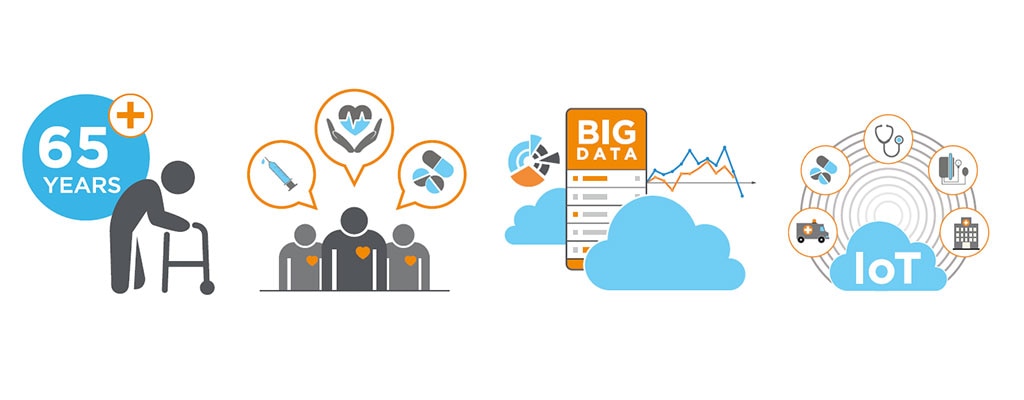
Trend Insight
Designing IoMT Solutions with Sensors
An interview with Bala Kashi, Medical Sensor Application Engineer, at TE Connectivity (TE).
Author
Content originally published in Medical Product Outsourcing.

What factors must be taken into consideration when designing custom electronic components for medical devices?
When designing custom electronic components for medical devices, there are many factors that need to be considered. Not only do factors such as understanding the application, validations, parameters, material selection, standards to be met, cleanliness and cost targets need to be acknowledged but there are other considerations. Some of these other considerations include the ruggedness, size, accuracy and scalability of the sensors since medical components can be exposed to various harsh conditions and medias. For example, if the sensor is being used for an implant application, it is required to be more critical for biocompatibility since it will have long-term contact with body parts. Additionally, the sensor will need to function long-term with almost no probability of fail.

Sensors enable the collection of data in various medical applications to change the way in which patients are treated and monitored. Learn how TE Connectivity (TE) is applying sensor technologies in the IoMT landscape for a healthier future.

Please discuss some of the challenges in designing and manufacturing custom electronic components for medical devices.
The design and manufacture of medical electronic components, including sensors, involves many challenges. Material selection, validation tests, quality systems, scaling and custom parametric tests are all examples of some of the challenges faced during this process. Since sterilization is a high priority within the medical industry, an additional challenge is the requirements regarding how components are to be manufactured – meaning, the space that they are developed within needs to follow specific guidelines to ensure a certain level of cleanliness required by the medical industry.

What are customers demanding or expecting in their custom electronic components?
The medical industry requires electronic component options for many different medical applications. However, there are some demands from customers that remain consistent since some sensing components measure various applications that relate to human life. For example, the accuracy and functionality of medical electronic components for life support devices is critical for that application. In addition, medical sensing components need to be reliable and meet all medical standards.

How is IoT (Internet of Things) influencing custom electronic component development?
There is a push towards developing sensing components that are suitable for IoT applications since sensors are the means to gather the data needed for successful deployment of these IoT applications. The data collected by sensors can help medical professionals understand critical situations faster and more accurately and enable patients to be more informed about their conditions and improvements. For example, if the sensor is being used within an in-home care application, it might have a wireless transmitter to send the data remotely to the cloud. Physicians or the patients can have the ability to download the data for analysis. Additionally, the sensor devices are required to be accurate, precise and reliable to avoid false triggering of any event. From blood pressure sensing to dialysis equipment monitoring, invasive and non-invasive sensors are providing localized data and information to the cloud to better serve patients and the medical industry.

How is big data influencing custom electronic component development?
Big data is influencing custom electronic component development in a positive way. The feedback that is gathered by big data can influence the functionality and the parameters monitored. For example, since the patient data will get stored remotely, it is possible to analyze this big data to understand the predictability prior to the occurrence of an event. The big data analysis can check for effectiveness of the treatment by age, gender, race, location, and patient habits. Therefore, with this information, the treatments can be more customized to specific patients. In the future, there will also be an increasing emphasis on smart sensing, using on-board sensor capabilities to analyze data and transmit ’vital data’ rather than simply ’big data’.


How is AI (artificial intelligence) influencing custom electronic component development?
Similar to the positive impacts of big data, artificial intelligence (AI) allows for predictability before any patient event. Based on patient patterns, AI not only enables the ability to predict a patient event but act on that event. For example, AI can provide notifications to paramedics or the physician if the medical machine is failing or if the patient is showing certain symptoms. Additionally, AI can interact with other devices that are hooked to the patient.

Is the trend toward miniaturization of medical devices driving a need for flexible custom electronic components?
Wearable and portable devices require smaller, lighter and less power-hungry devices that allow for more sensing functionality within one device. Devices such as these require more resources to develop and are more expensive to build. Therefore, during the design phase, there is a need to consider multiple other potential applications and try to address them, as well.
Sensor Solutions for Wearable Technology
-
Sensors for Wearables
The expectation of connectivity anytime, anywhere drives the need for wearable products. And as TE sensor platforms bring wearable technologies to life, users become safer, more productive and healthier. Learn more about the sensor solutions for wearable technology.

How else is miniaturization impacting custom electronic component development?
With the drive towards developing miniaturized components, there have been impacts within the development process. Time and cost associated with development has increased due to the increased resources and the additional testing needed to confirm products work efficiently. There is also the need to fit all the same functionality into a smaller package. For example, shrinking sensor devices will take a lot of engineering. It will be costly since new designs may be required, in addition to, using expensive material and precise components. There will also be the need for highly accurate manufacturing techniques since the devices will be so small. To ensure performance won’t be compromised, the new devices may be required to go through extensive validation tests, third party certifications, etc.

In what ways is the changing regulatory environment impacting custom electronic component development?
Regulatory practices will add a layer of safety for the product and application. The evolving regulatory environment has been impacting development and manufacture of electronic components. Because of these regulatory impacts, unit cost of products is likely to increase due to the need to perform new and incremental testing to meet these new standards. In addition, some custom parts may warrant modification or redesign.

How are requests for low-power design impacting custom electronic component development?
The need for low-power design is increasing with the advancements in the IoT application space. Therefore, the impacts have included digitizing sensing components and designing them in a way that allows the capability to gather data on demand rather than continuously taking measurements. In addition, there is a shift to including signal processing at the receiver rather than at the measuring device.

Is your company impacted by green initiatives from medtech customers in Europe or the U.S.?
With the shift in focus to considering environmental regulations and adopting green approaches, TE Connectivity (TE) has taken steps to provide more environmental-friendly products. For example, TE has taken steps to replacing some materials that were noncompliant with environmental regulations. TE is also in the process of identifying some alternative materials that can be integrated into existing and new products.

Please discuss any other trends you are noticing in custom electronic component development for medical devices.
Many of the advances will be incremental. There will continue to be advancements in miniaturization, performance, artificial intelligence and price for digital and wireless sensing. With the developments within the Internet of Medical Things (IoMT), there will also be an increasing emphasis on portable, wearable devices to monitor patients to enhance remote operating capabilities.

Explore More Medical Solutions



